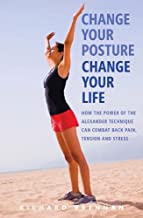Information about the ways in which the Alexander Technique can help you have an easy upright posture, without excess strain or tension:
Alexander Technique & Posture Audio
Listen to or download: How the Alexander Technique can help you improve your posture:
This and several other podcasts about posture and the Alexander Technique can be found at Body Learning Cast
Alexander Technique & Posture Videos
Short video about posture, pain and the Alexander Technique from ABC News:
Posture myth-busting: It’s easier than you think:
Alexander Technique teacher Adrian Farrell distinguishes posture from poise:
Alexander Technique & Posture Books

Order The Posture Workbook from:
- Amazon.com (USA)
- Amazon.ca (Canada)
- Amazon.co.uk (UK)

Order Change Your Posture, Change Your Life from:
- Amazon.com (USA)
- Amazon.ca (Canada)
- Amazon.co.uk (UK)
More Alexander Technique Books at the Alexander Technique Bookstore (USA, Canada and the UK) .
Alexander Technique & Posture Articles
Alexander Technique and “Good Posture”
Some of the best short writings about the Alexander Technique and posture can be found in blog posts on the topic by teachers of the Technique. Here are two particularly good selections:
Robert Rickover’s posture posts
Additional articles about the Alexander Technique and posture:
- Increased dynamic regulation of postural tone through Alexander Technique training – 2010 Study published in Human Movement Science (PDF)
- Posture and the Alexander Technique
- The Pitfalls of High Heels
- ABCs of Good Posture by the Father of American Education
- Taking a Stand with Awareness
- Poise, Posture and Performance
- Posture Commands: Why They Don’t Work
- Chairs, Posture and the Alexander Technique
- The Chair as a Health Hazard
- Posture and Pain – Does Your Back Hurt
- Human Posture – Blog
